Dine on Dim Sum this Lunar New Year at a Classic Chinese Restaurant in Metro Phoenix

The original story was published in Phoenix New Times in January 2023.
One of the largest and oldest traditional holidays in China is the Lunar New Year, which this year starts on January 22. The first day of the celebration varies from year to year, depending on when the moon lines up with the sun and the Earth. After that, the festivities go on for 15 days.
It’s also referred to as Chinese New Year, says Reneez Ho, one of the many employees at the Phoenix Palace Restaurant in Chandler. She’s also the owners’ daughter and spokesperson for the Ho family restaurant which opened in 2006.
“I started helping out at a very young age, probably 8 to 10 years,” she continues. “Chinese New Year is very festive in China as work and school are given a vacation to celebrate with family. Especially in the cities of Chandler and Mesa, there are multiple plazas that are top spots for the culture.”
Festivities for the holiday — complete with red paper decorations and little envelopes, gifts, and scrumptious food — continue throughout the Valley.
Regarding festive food, dim sum dishes are served during Chinese New Year to bring good luck for the year ahead. Dim sum, which translates to “touch the heart,” are savory and sweet snacks traditionally served with tea. The small plates, also called yum cha, are predominantly eaten in the morning until about brunch time, rather than for dinner. The offerings come in various styles, flavors, and textures, and are served in multiples in modular steel or bamboo steamers.
Phoenix Palace Restaurant is located in Dobson Park Plaza, a shopping center anchored by the Lee Lee International Supermarket in Chandler. There, the dim sum menu has about 20 items and is served from 10 a.m. until 3 p.m. The rest of the Cantonese-inspired menu is served until 9 p.m.
Upon entering the restaurant, customers are greeted by large Chinese sculptures in the foyer and checkout counter. In the front, there’s a large display with Cantonese characters explaining its significance.
“It’s a statue of a bucket for coins and money,” Ho explains. “It’s meant to bring in fortune to the restaurant.”
After taking a seat, one of the many servers dressed in a white tuxedo-like shirt and black vest offers drinks and leaves a white piece of paper with Cantonese characters on the table; it’s an order form. The dim sum carts follow.
Each dim sum dish is presented in a 4 to 6-inch stainless-steel steamer or on a plate. The server removes the lid from each container, to expose the contents and give a brief description of each food.
“This is shui mai, pork and shrimp dumplings; shrimp har gow; scallop dumplings; and shark fin gow,” she says. They sell for $4.30 per order which includes three to four pieces.
If customers like what they see, they can select the dish and the containers are placed on the tables. The server then updates the table’s paper ticket.
Chicken feet, which in the dim sum world translates from Chinese to English as “phoenix claws,” is a popular dim sum dish. The steamed chicken feet are coated in a tangy sauce and are primarily composed of chicken skin and tendons with a gelatinous texture. Beef tripe is another meaty dish that is also gelatinous and has a hint of ginger flavor.
With the shrimp rice noodle rolls, which cost $5.30 per order, the server uses a pair of scissors to cut each roll in half, before pouring on a brown soy-based sauce.
Another cart that comes around contains sweet and savory pastries. The barbecue pork buns, served in trios, have a shiny top glistening with oil and tangy meat inside. The sweet pastries are equally as fresh.
“The process takes a long time as both the stuffing and wrappers are handmade,” Ho says of the savory and sweet treats. A new batch is carted between the tables every 10 to 15 minutes.
The coconut rolls have a springy texture filled with sugary and shredded copra, or coconut meat. The sesame balls, one of the more popular sweet dim sum, are juicy, deep-fried balls with a sesame seed shell and a sweet gelatinous rice flour and red bean filling.
There is also no particular order in eating the savory pieces before the sweet pastries or vice versa. And for larger parties, some tables have lazy Susan turntables so everyone can grab a variety of dim sum with the restaurant’s glossy black-colored chopsticks with ease. The staff also provides forks and spoons.
A third cart also weaves between tables with non-dim sum items such as Chinese noodle soup and chow mein.
According to old folktales, eating multitudes of dumplings during the Chinese New Year festivities will lead to a prosperous year ahead. Regardless of the future, it’s hard not to feel fortunate after tasting the juicy shui mai at Phoenix Palace.
Phoenix Palace
2075 North Dobson Road, Chandler
480-855-4047
phoenixpalacechandleraz.com
